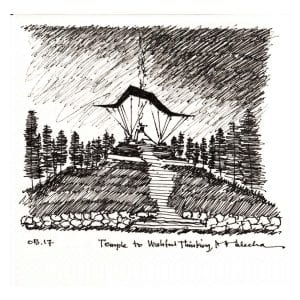On May 19, NewSchool’s chapter of the American Institute of Architecture Students hosted its annual Napkin Sketch auction. The event raised $3,800 to help students attend industry conferences. This year, there were 36 sketches contributed by 20 architects, including NewSchool president Marvin Malecha, who contribute five. Here he shares his perspective on napkin sketches.
The napkin sketch holds a hallowed place in design history. It is a medium that is at once frivolous and the carrier of sublime design ideas. The paper napkin is ephemeral. It is a fragile medium best suited to ideas of the moment. In the course of a design project it becomes tempting to use whatever means possible to convey or record an idea. It is therefore important to understand the bias of the individual who is drawn to such a medium.
I have my own experience with a seminal design idea recorded on a drink napkin that guided the work of a team through a complex client community. The sketch became an informal/formal basis of agreement regarding the progress and direction of the Chancellor’s residence at North Carolina State University after a lengthy and sometimes uncomfortable search for the right expression. However, for me this use of a napkin sketch is an anomaly. I have a hierarchy of papers and pencils that demark the exercise of sketching on a substantial pad, to more professional communications recorded in a notebook. The napkin sketch is an exercise of folly and free daydreaming. Please do not misunderstand me: free daydreaming is one of the most important regular exercises that a creative individual can undertake.
This is the best way to describe the sketches titled “Temple to Wishful Thinking” and “Beach Folly.” Both sketches are simple musings about life and site, the sacred and the inconsequential.
The pursuit of the idea of sacred is represented in the sketch titles as “Path to a Sacred Place.” This sketch is a bit more intense than the first two in that it represents the uphill struggle, often in less than ideal places, to achieve the sacred as it is represented as the bright light at the end of an uphill journey. The bright light recurs in my daydream sketches. It is my belief that the better is always ahead even though great darkness must sometimes be traversed. This optimism is reflected in the titled greeting the sky. The tower reaching out of the darkness, like the light at the end of the path is an expression of optimism.
The final sketch, “’Interwoven Trees’ of Life,” is a frequent exploration for me. It is an ancient symbol of family and the strength derived from a mature family unit. The natural forms derived from the tree trunks interwoven to carry a unified tree canopy is nature’s way to dramatically illustrate the model for the human family.
Is the napkin sketch folly? Yes. But it is through free exploration that folly provides that serious subjects may be pursued. Like staring out of a classroom window drawn to the miracle of a spring day, folly is after all serious business.








 619-684-8800
619-684-8800




